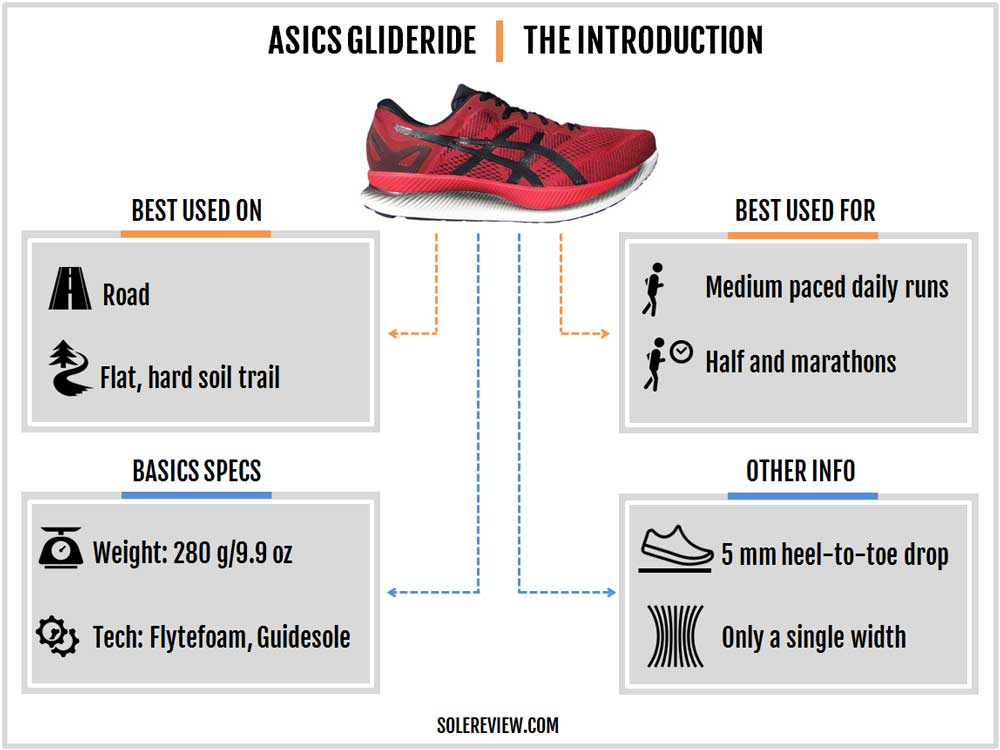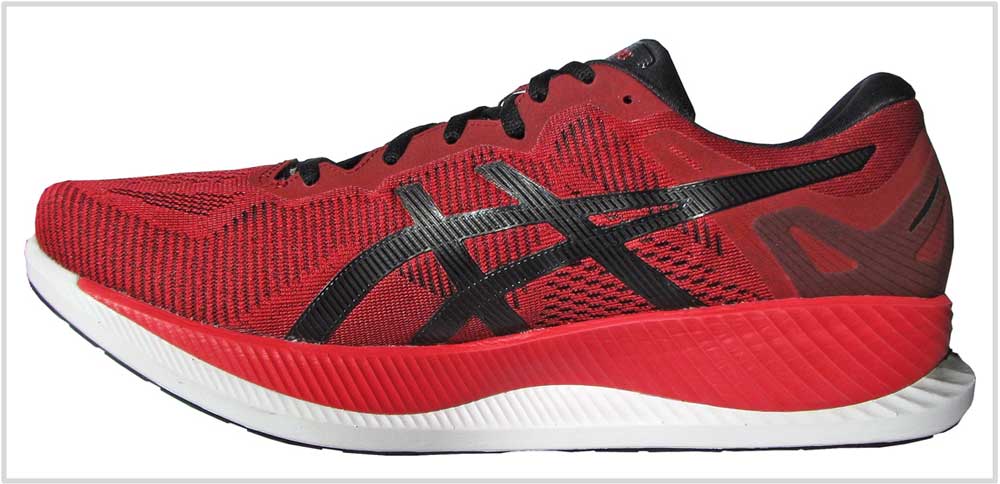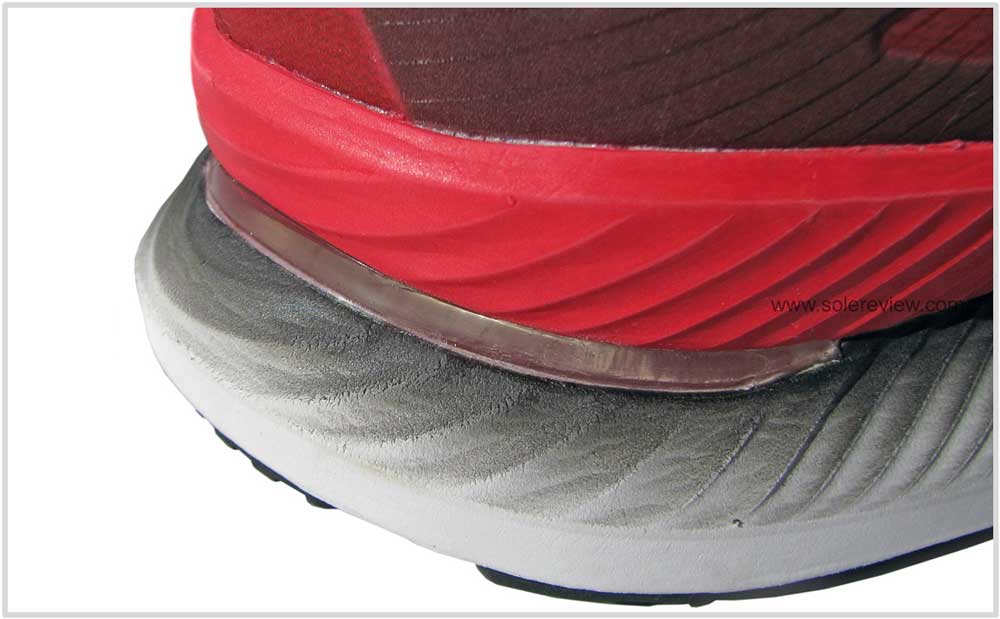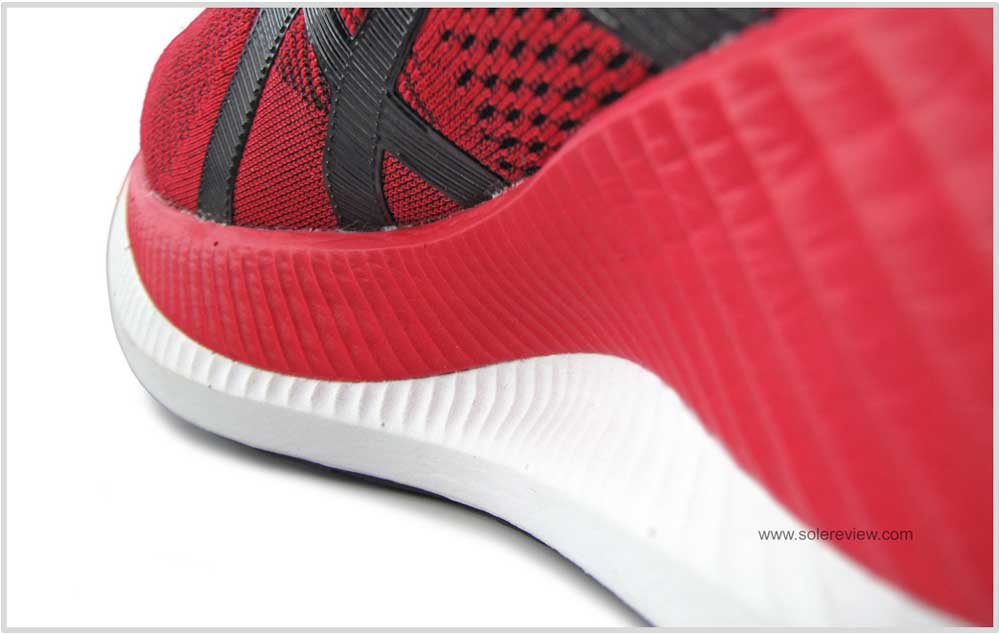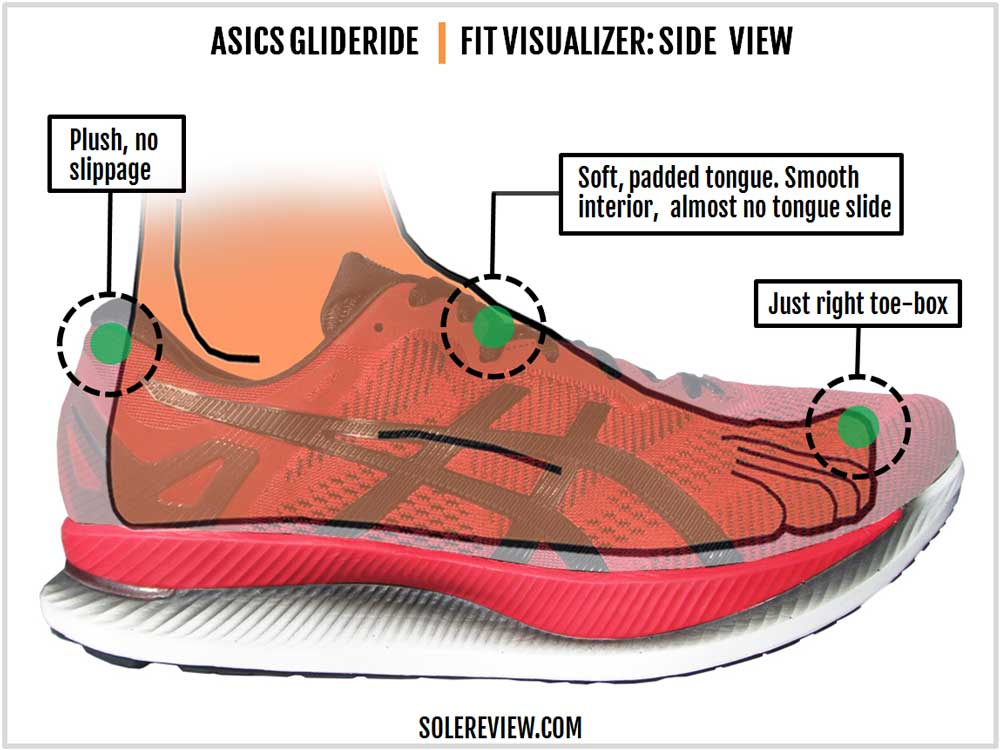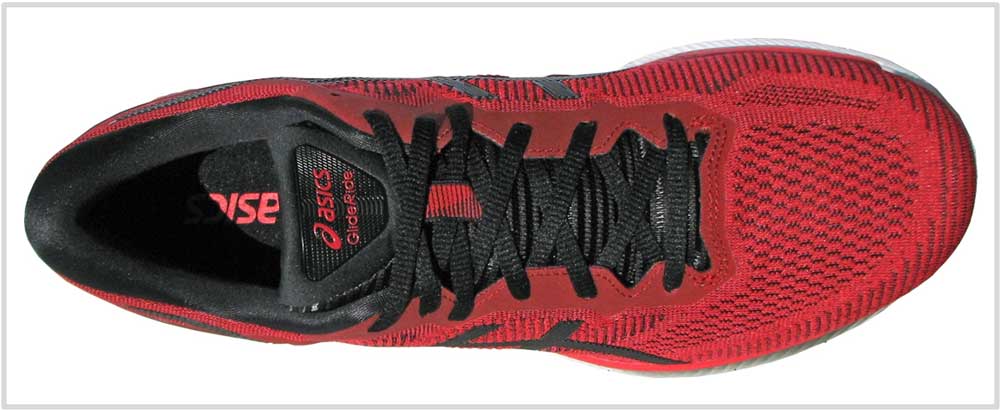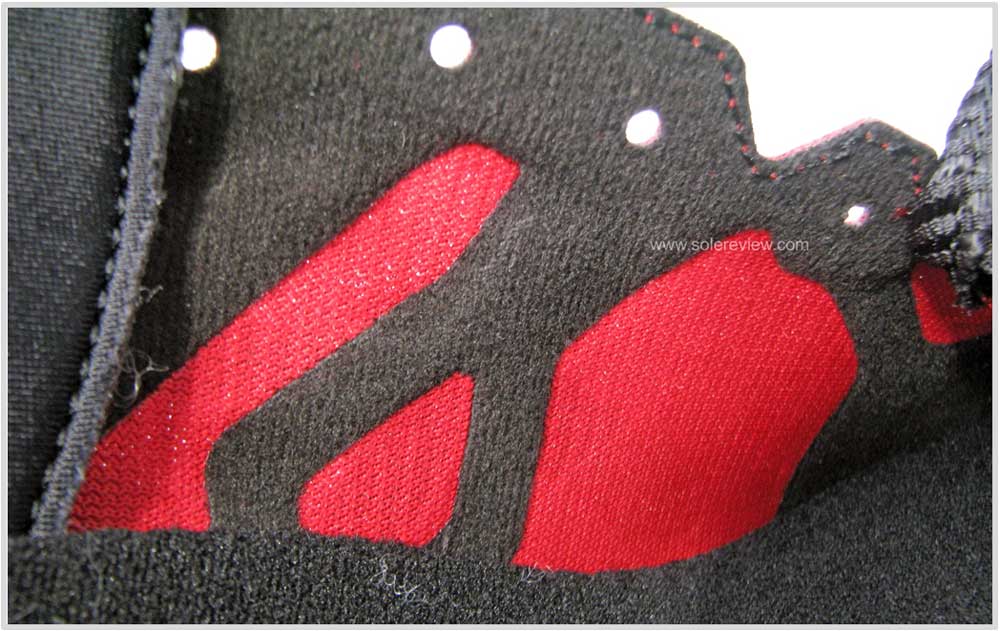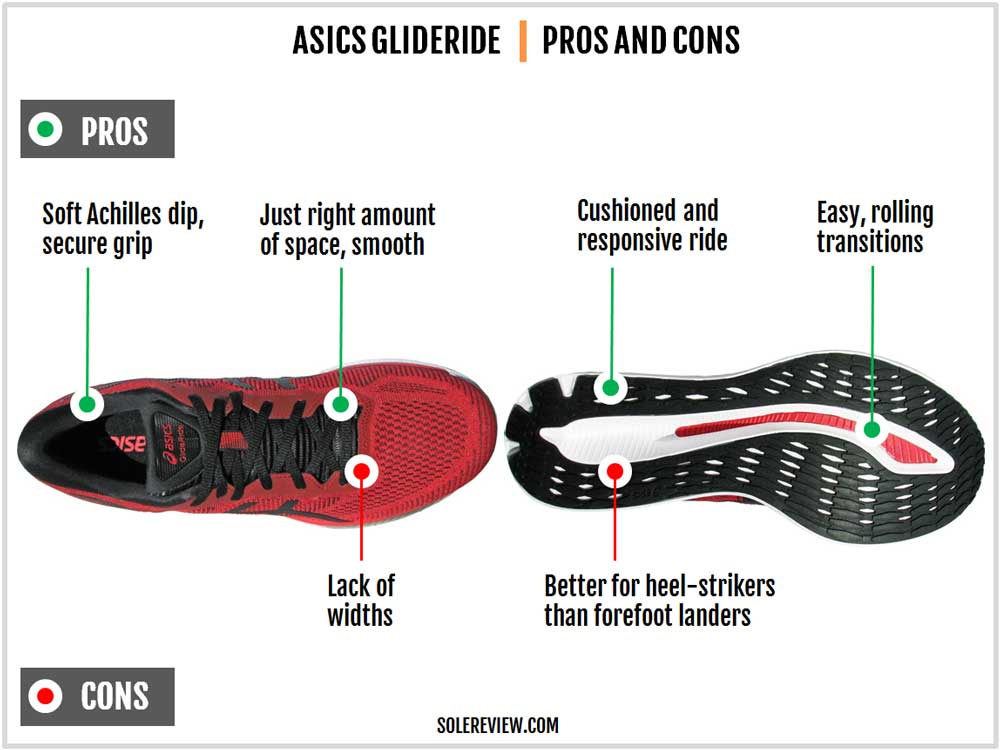INTRODUCTION
The Glideride is the best Asics running shoe we’ve tested in a very long time, and that’s saying something. From a shoe reviewer’s perspective, this is a great way to end a year that included reviewing the mediocre Nimbus 21 and a few competent yet predictable Asics products.
The staleness of the Asics product line has been a recurring lament in our reviews. But not this time; the GlideRide feels like a gust of fresh air in a stale room.
Asics’s last tryst with newness resulted in the disaster that was the 33 series. While the infamous 33 series was an unwanted force-fit, that isn’t the case with the GlideRide; this is a thoughtfully-designed running shoe that lives up to its advertising.
We’re also noticing a change in Asics’s overall design language, a move that signals the Japanese brand’s willingness to break out of its rut. It’s not just the GlideRide; the redesigned Nimbus 22 looks completely transformed from the outside. We’re yet to review the 22 but we hope that the ride experience feels just as new as its styling.
So what’s the deal with the GlideRide?
This is a running shoe with a rigid plate. Before you roll your eyes and say ‘where have we heard that before’, know that the GlideRide isn’t anything like the Nike Vaporfly or Next %.
Here, the Nylon(?) plate embedded within the midsole doesn’t create a spring-like effect under the heel. It is intended to create a forward-propelling rocker motion, and that’s exactly how it functions.
It’s worth mentioning that the GlideRide’s high toe-spring works better for runners who land rearfoot than forefoot strikers. We’ll explain why in the ride experience break-out.
The rest of the shoe feels great. There’s plenty of cushioning in the stacked midsole, and the upper fits great too. And for a change, this Asics running shoe even manages to feel lively and responsive during runs.
The ‘Guidesole’ design isn’t pace dependent. Be it leisurely runs or high-paced workouts, the Glideride works equally well.
ASICS GLIDERIDE VS. THE METARIDE
Even with the rigid plate, there aren’t many shoes that are similar to the Glideride. This rocker-shaped shoe has only one direct competitor – the Asics Metaride.
The Metaride is a dressed-up, more lux version of the Glideride. At the same time, it’s an ounce heavier with a zero-drop midsole – as compared to the Glideride’s 5 mm heel-to-toe offset.
The zero drop is likely the result of a high toe-spring. Here, the slope is measured from the heel center to the midfoot – as opposed to the heel-forefoot offset of traditional running shoes.
The Metaride is noticeably heavier, and it’s pretty easy to see where that is coming from. The upper has a plastic clutch, the Gel pads are larger, and components such as the glossy outsole and the denser insole add weight.
The upper fits narrower and slightly shorter than the Glideride because the packed heel collar and the clutch reposition the foot forward. The mesh is softer than the Glideride but is stretchy – a feature that the cheaper Asics shoe lacks. The elasticity adds to the Meta’s snugger upper fit.
As far as the ride is concerned, our vote is on the Glideride. It’s softer and lighter than the $100 more expensive Metaride – and you get a similar rocker-midsole experience. The Metaride is a nice running shoe but it is not worth the $100 upcharge.
THE RIDE EXPERIENCE
The first run in the Asics Glideride felt very familiar; the experience of the forward rolling motion wasn’t a new one. Many years ago, we reviewed a running shoe called the Mizuno Wave Prophecy 1.
Just like the Glideride, the Prophecy featured an extremely high toe-spring. The MBT line-up of shoes also had a toe-spring but with a difference. They also had an equally high heel spring – which isn’t true for the Asics Glideride.
In plain English, the toe-spring refers to how high the front of the shoe angles upwards. All running shoes have a toe-spring because it becomes easier for the foot to push-off at the end of the gait cycle. And ‘easier’ is the key term here – and that’s pretty much the gist of the Glideride (and the Metaride) experience.
The forefoot is inflexible and very rigid due to the TPE (or Nylon?) plate extending from the midfoot to the toe. This plate is what gives the shoe its signature toe spring – it touches down under the ball of the foot before curving up in either direction.
And it works.
Transitions feel effortless once you load on the midfoot and lead from the forefoot. Since you run out of the midsole from the rocker point, the body tends to roll forward and makes take-offs easier. Not having to labor through the transition process is very enjoyable.
There’s a bit of a struggle when loading from the heel to the point where the plate begins. The heel is 31 mm thick, and there’s plenty of cushioning available underneath. Two layers of Flytefoam, some Gel, a soft foam lasting and insole make things very cushioned.
When landing on the rear, you hit the cushioned sweet spot of the Glideride first. There’s a slightly disconnect when you’re making the switchover to the plate part of the shoe – it’s not a lot, but you do notice it.
Forefoot strikers do not get the landing sweet spot due to the exaggerated toe-spring. While you’ll benefit from the roll-off motion during take-offs, it’s not quite the same. Rearfoot strikers stand to benefit the most from this rockered set-up.
Even if your style is full-contact landing – otherwise known as midfoot landing – it feels like you’re missing out on the fun. Again, the roll-offs feel as easy as it is for rearfoot strikers, but you don’t get to experience the whole Glideride package.
It’s not just the plate. The transition groove is the deepest under the heel than anywhere else, so a heel striker will ride through the entire groove – from the deep end to shallow. The Glideride’s ‘guidance line’ is the most effective example we’ve seen so far. It keeps the ride centered while providing cushioning by splaying under the bodyweight.
It’s been a long time since we used the words ‘lively’ and ‘responsive’ in an Asics shoe review. But today is the day; this shoe has plenty of cushioning without a trace of soggy mushiness.
The midsole is actually responsive – the heel has a bouncy feel and the curve of the plate creates a springy effect under the forefoot.
The Flytefoam midsole works extremely well as a dampener. During runs, it’s hard to tell the plate apart from the foam midsole. The different foam densities and the rigid plate are meshed well together to deliver a smooth and consistent feel.
Though the outer heel midsole is grooved inwards (whereas the inner sidewall is not), the ride feels fairly unbiased and neutral.
The lower midsole has flares outwards so that adds to the neutral and supportive character of the Glideride. This is also one of the few Asics shoes to feature a single-piece, contact-friendly outsole. That too adds smoothness to the ride quality.
When it comes to use-cases, the Glideride is very versatile. This isn’t a running shoe that only feels good above a certain pace. The rocker plate doesn’t discriminate, regardless of whether you’re running 6 min/km or 4.30 min/km. Fast or slow, the rocker midsole has your back.
The only difference is that the transitions feel more efficient at a higher pace. As in, the loading from the deeply cushioned heel to the snappier midfoot feels better connected.
The just-right level of cushioning softness and depth makes the Glideride suitable for long training runs, marathons, and everything in between. If you want nothing more than a daily trainer, then the Glideride is up for that too.
Heck, the rolling outsole design and the rocker midsole make the shoe walking-friendly too.
Asics, we’re pleased with what you’ve done here.
Your daily training and long-distance needs are covered with the Glide. So what’s left? A lower-profile, speed shoe? You can get the Dynaflyte 4, the Tartheredge, or both.
Outside of Asics, the adidas Boston 8 and New Balance 1400V6 are your options.
IS THE ASICS GLIDERIDE DURABLE?
If we had to put a number here, 400 miles sounds just about right.
The upper is solidly put together and the outsole hasn’t shown much signs of wear in 50 miles. The outsole’s flat lug structure also helps reduce the wear and tear.
THE UPPER DESIGN AND FIT
The Glideride’s upper has an excellent fit. It fits true to size and comes with enough room above the toes. The front has a broad profile, courtesy of the internal bumper that creates space in the front.
The forefoot also fits just-right with sufficient splay room for the foot. The lacing does affect the fit, so going easy on the cinching will free up some room.
Our fit feedback is for the D width. At the time of writing this review, the Glideride is not offered in additional widths.
We would love it if Asics adopted this fit template for all their trainers. The Glideride’s upper fit achieves a near-perfect balance between comfort and a secure lock-down.
The insides feel very smooth. The exterior is constructed using a single piece of engineered mesh without a lining layer or a sleeve.
So it was a pleasant surprise not to experience a lot of tongue slide. The flat laces sit flush over the soft tongue and keep it locked down during runs. The tongue length and volume of foam fill is just right too.
It also helps that the lacing panel isn’t thick. It is reinforced on the inside without making the edges thick. The medial upper is more supportive than the outer side, as it has fused panels made of a soft synthetic.
In the rear, the heel locks in very securely – even without using the optional heel-lock lacing. The collar height and padding are gentle on the Achilles without slippage. There’s a proper molded counter inside that hugs the foot.
Though the Glideride doesn’t have the reflectivity of Asics’s Lite-show collection, the heel has a pair of low-visibility trims.
PROS AND CONS
We have many good things to say here. Ok, maybe the shoe falls short for runners who aren’t rearfoot strikers. But if you are one, there are plenty of reasons to like the Glideride.
The upper fit is excellent with just the right balance of space and secure lock-down. The same goes for the cushioning too – which is a nice blend of softness and responsiveness.
And the high toe-spring midsole ties everything together by making the Glideride easy to run in. A couple of optional widths would have also been nice.


